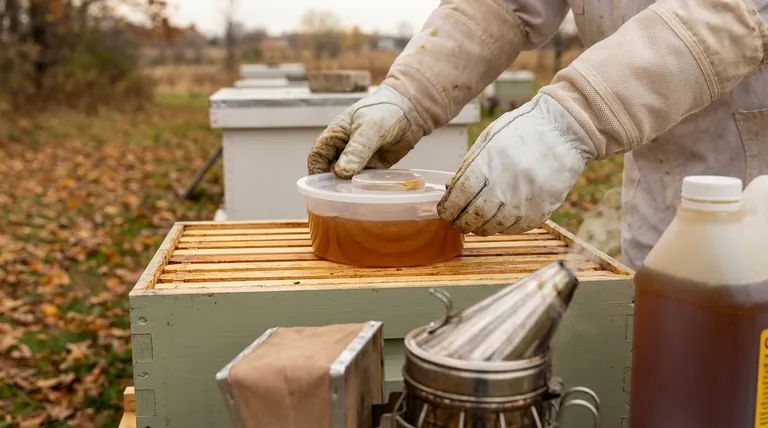For bee colonies with insufficient stores for winter, you must intervene by feeding them enough sugar syrup to boost their reserves. This feeding must be done before the cold weather of autumn fully sets in, as the bees require warmth to properly process the syrup and store it for winter consumption.
The primary cause of honey bee colony death during winter is starvation. The beekeeper's role is to accurately assess food stores in late summer and early autumn and provide supplemental feeding if natural stores are inadequate to prevent this outcome.

The Unforgiving Logic of Winter Survival
A honey bee colony's survival through winter is a battle against cold and hunger. They rely entirely on the food stores they've gathered to fuel their winter cluster.
Energy for Warmth
Bees do not hibernate. Instead, they form a tight winter cluster around their queen to generate heat.
They produce this heat by vibrating their wing muscles, a process that consumes a massive amount of energy. Their stored honey is the high-energy fuel for this vital activity.
The Consequence of Empty Stores
Without adequate food, the colony's "furnace" runs out of fuel. The bees can no longer generate heat, the cluster temperature drops, and the colony freezes and starves.
This is why ensuring sufficient stores is arguably the most critical task for a beekeeper preparing a colony for winter.
Taking Action: How and When to Intervene
Intervention is straightforward, but its success depends entirely on proper timing. The goal is to supplement, not replace, their natural stores before it's too late for them to use your help.
The Right Food: Sugar Syrup
The standard supplemental feed is a heavy sugar syrup. This provides the dense carbohydrates bees need to convert into stored energy, closely mimicking the properties of honey.
The Critical Timing
You must provide this syrup before the cold weather arrives. Bees need ambient temperatures to be warm enough to break cluster, access the feeders, and process the syrup.
Once temperatures consistently drop, they will be unable to process liquid feed. The introduction of syrup at this point can also add excess moisture to the hive, creating other problems.
Learning from a Lost Colony
Even with the best preparation, losses can occur. Examining a dead colony provides invaluable information for the future.
Conducting a Post-Mortem
If you find a dead colony in the spring, a quick examination is essential. Note the position of the dead bees and, most importantly, the status of the food stores.
Starvation vs. Other Causes
If the hive frames are completely empty of honey and the dead bees are often found with their heads in empty cells, starvation was the definitive cause.
If significant honey stores remain, the colony likely perished from another cause, such as disease, moisture, or a weak population. This distinction helps you refine your management practices for your surviving colonies.
Making the Right Choice for Your Goal
Your approach should be guided by proactive monitoring and decisive action.
- If your primary focus is preventing winter loss: Regularly inspect your hives in late summer and early autumn to gauge the weight and volume of their stored honey, allowing ample time to feed if necessary.
- If you discover a colony is light on stores: Begin feeding a heavy sugar syrup immediately, ensuring you provide enough for them to build substantial reserves before daily temperatures drop consistently.
Ultimately, your diligence in the autumn directly determines your colonies' chances of survival through the winter.
Summary Table:
| Key Action | Purpose | Timing |
|---|---|---|
| Assess Honey Stores | Determine if supplemental feeding is needed | Late Summer / Early Autumn |
| Feed Heavy Sugar Syrup | Boost energy reserves for winter cluster | Before consistent cold weather sets in |
| Post-Mortem Examination | Identify cause of death (e.g., starvation) to improve future management | Spring |
Ensure your apiary thrives through winter. Don't let starvation claim your colonies. HONESTBEE supplies commercial apiaries and beekeeping equipment distributors with the high-quality feeders and essential supplies needed for effective supplemental feeding. Our wholesale-focused operations ensure you get the reliable equipment required to protect your investment. Contact our experts today to discuss your winter preparation needs.
Visual Guide

Related Products
- Rapid Bee Feeder White Plastic 2L Round Top Feeder for 8 or 10-Frame Bee Hives
- Professional Dual-End Stainless Steel Hive Tool for Beekeeping
- HONESTBEE Advanced Ergonomic Stainless Steel Hive Tool for Beekeeping
- Professional 3-Bar Frame Grip with Integrated Hive Tool
- Yellow Plastic Bucket Pail Perch for Beekeeping
People Also Ask
- Can sugar syrup contaminate the honey crop? A Beekeeper's Guide to Protecting Honey Purity
- What is the best thing to feed bees? A Guide to Supplemental Feeding for a Thriving Hive
- What can the round hive top feeder be used for? A Guide to Efficient, Safe Bee Feeding
- What are the recommended sugar-to-water ratios for making sugar syrup for bees? Optimize Your Hive's Health
- What is the capacity of the round hive top feeder for syrup and pollen? A Guide to Targeted Apiary Support



















